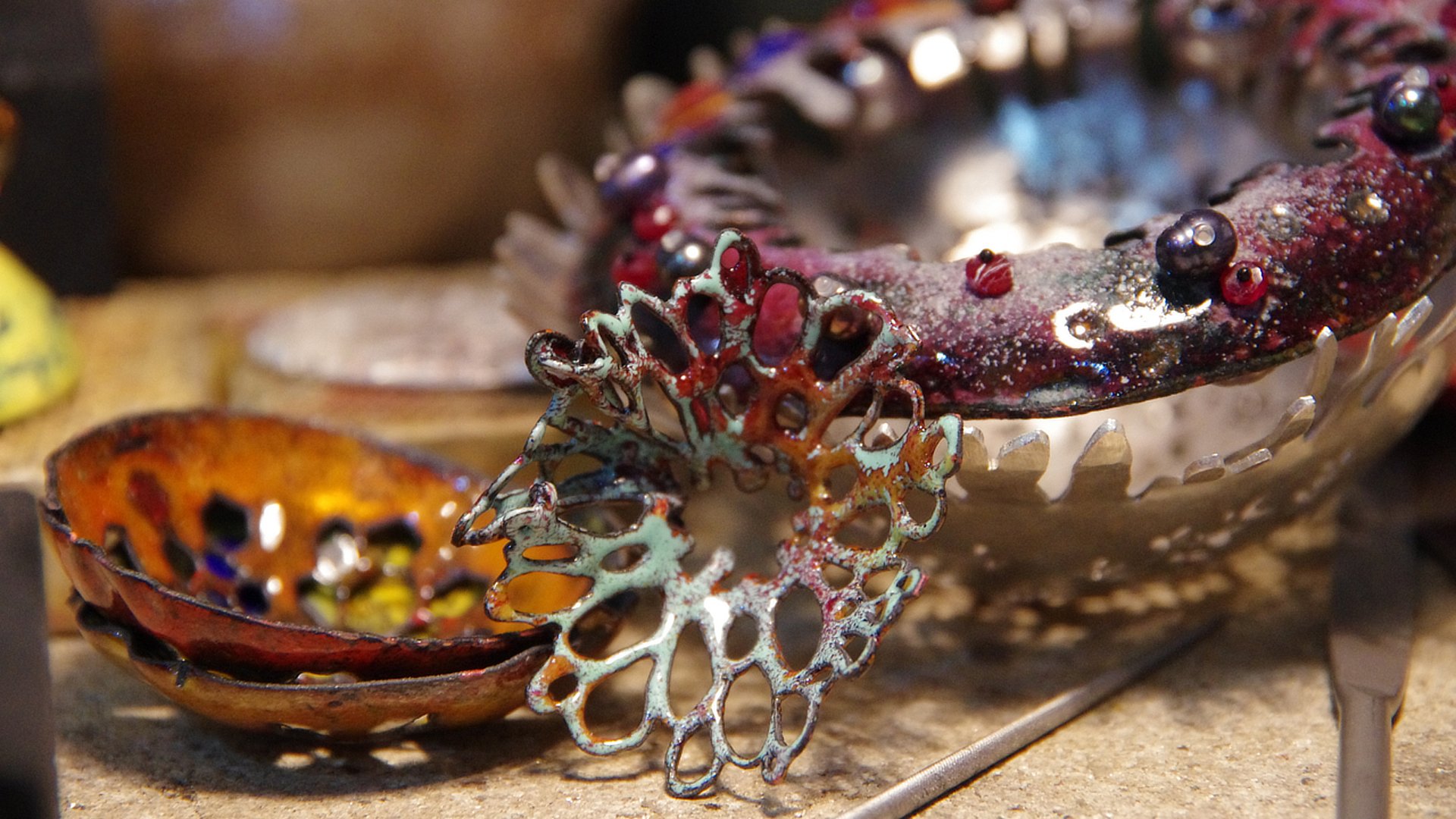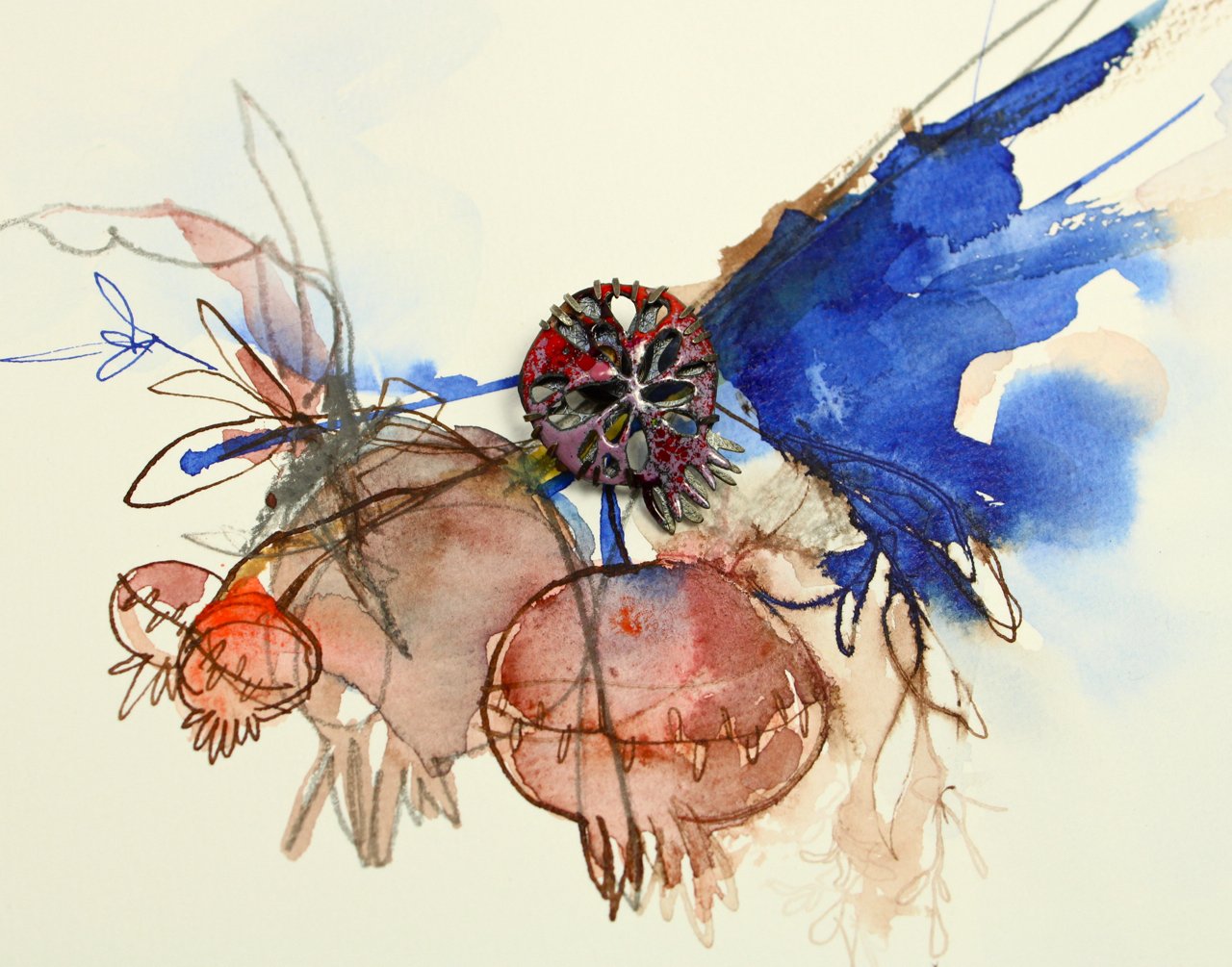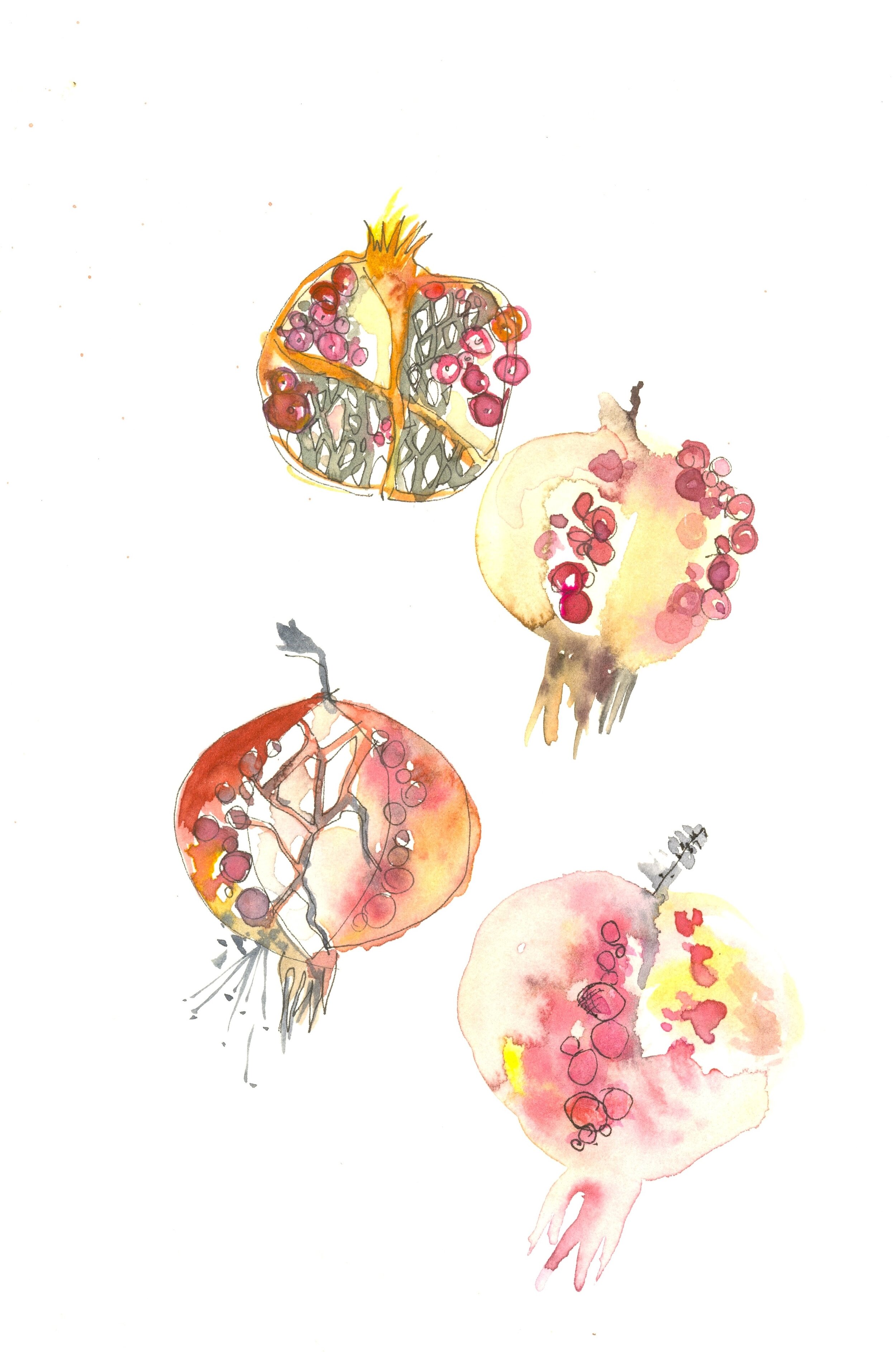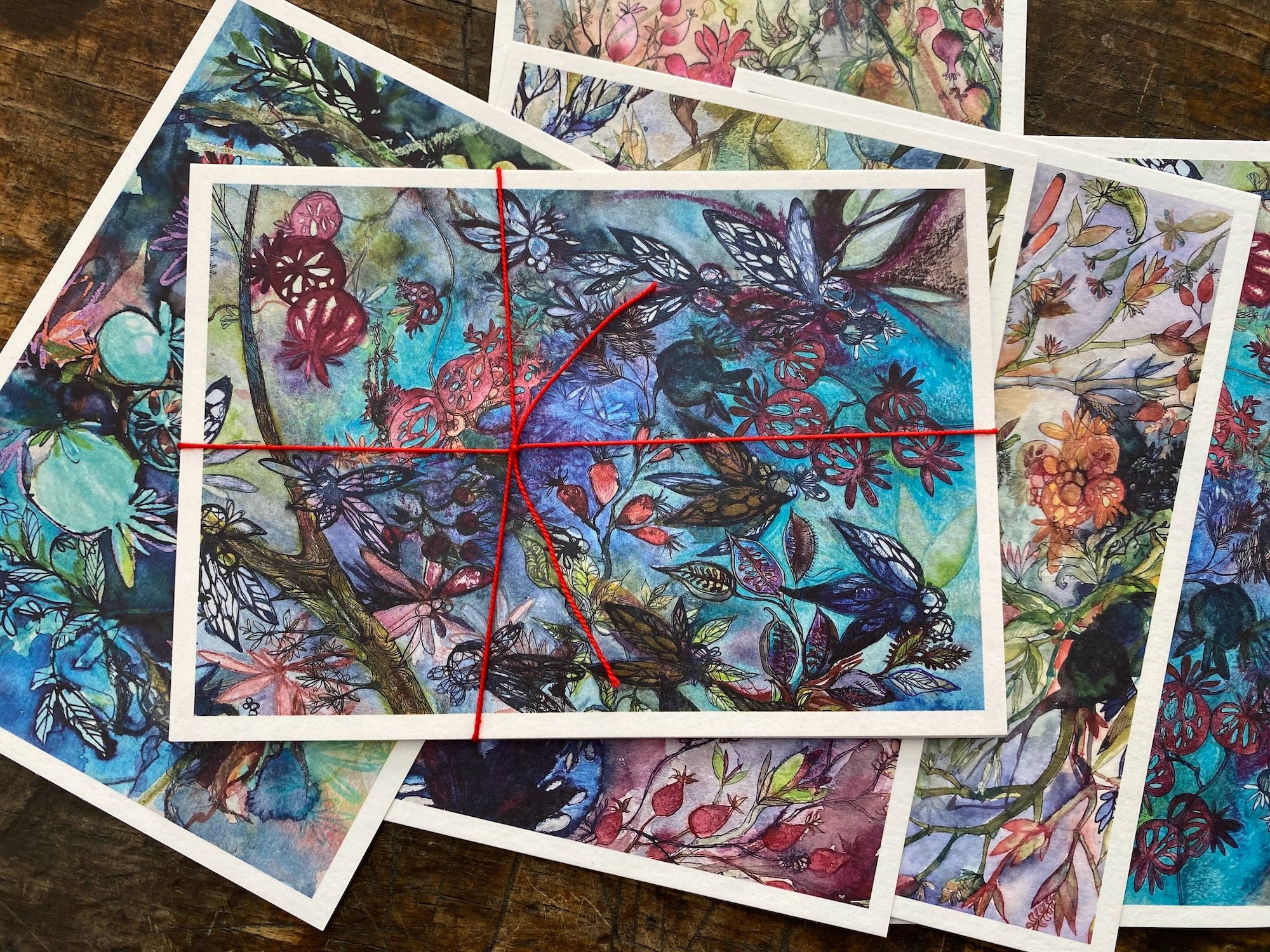
blog
Welcome to my blog. This is a place where I think out loud, show you what I’m up to in the studio, share impressions of inspiring events or everyday moments that moved me. Some entries are carefully curated essays, others are just a few thoughts, sometimes written in English and sometimes in German.
Featured posts

newest blog entries:
The Pomegranate
The pomegranate is a treasury of symbolism: it is not only emblematic of passion, sensuality and sexual love, but also speaks of a very powerful and perhaps threatening knowledge: a liberating sense of sexual self-reflection and confidence, the very opposite of innocence.
Pomegranates, to me, are the ultimate symbol for the sacred feminine. They tend to feature heavily in my botanical watercolour paintings and jewellery.
My first Pomegranate Fantasy brooch, an enamelled ode to Persephone, to summer, to colour, and to Eros in its multitude of meanings - an antidote to dying.
The pomegranate, more or less abstracted, has established itself as the most prevalent shape in my creative practice over the past six years. It has become the blushing red thread connecting my art jewellery to my sculptural objects to my miniature and large paintings, and a central feature in my botanical compositions. Perhaps even more surprising, the conglomerate of pomegranate-associations has become a cluster of ideas that are omnipresent in my life, my search for self-knowledge and my need to make sense of our world and its cyclical systems. As I started to trace the origin of this pomegranate fascination – even obsession – of mine, I dove deeper and deeper into the fruit’s cultural history and mythological significance.
I grew up with pomegranates. Even though it’s not one of South Africa’s most important exports, I was aware of its existence from a very early age: my grandparents had several trees (still do to this day), the oldest of which is a gnarled drooping thing next to their front door. The pomegranates used to grow and shape themselves into green orbs slashed with magenta and later crimson as my birthday was approaching. I remember always hoping that at least one would be ripe and ready and bursting with gemstone seeds for my birthday celebration, but they never quite managed to comply. The fruit clearly captured my imagination from this early age on and still continues to do so today.
These tiny pomegranates for your ears, hand-crafted in oxidized sterling silver, are available in my online shop here.
Pomegranate Storm, enamelled statement earrings adorned with peacock freshwater pearls and faceted garnets.
My grandparents' pomegranate tree that I was familiar with as a child.
One of my favourite books to browse in these days: "A Garden Eden - Masterpieces of Botanical Illustration". This is the work of Giorgio Gallesio, who lived in Pisa from 1817 - 1839.
The exotic looking fruit, Punica granatum, entered the orchards and mythology of the ancient world before most others. The pomegranate is indigenous to modern-day Iran and Northern Africa, from where it spread throughout the Mediterranean region. As I followed the pomegranate’s trail through history and myth and stories, I discovered how omnipresent it really was and still is in our cultural symbology canon.
With its plump rose-coloured exterior, its red juice and its abundance of gleaming ruby-red seeds that burst from the inside when the fruit is split open, the pomegranate is a powerful symbol of fertility and female sexuality. For many cultures, it represents sacred feminine power: the power of creation in all its forms. It was considered an aphrodisiac and therefore often presented at weddings. Ancient Sumerians believed that the souls of the dead ate pomegranate seeds to become immortal.[1] The Bible describes the pillars of King Solomon’s monumental temple decorated with complimentary male and female fertility symbols: lilies with their long narrow shafts, and pomegranates.[2]
In Jewish tradition, pomegranates are traditionally eaten on Rosh Hashanah (Jewish New Year), as it was believed that pomegranates always have the same number of seeds – 613 – coinciding with the 613 commandments of the Torah. In all major monotheistical faiths, scholars believe the pomegranate, rather than the apple, possibly to have been the forbidden fruit in the Garden of Eden. In Roman times, pomegranate blossoms and fruits were worn as wreaths at spring festivities and other fertility celebrations. In a similar fashion, Buddhists believe that the pomegranate is one of the ‘Three Blessed Fruit’, denoting fecundity and prosperity.[3]
A Persian or Indian velvet tapestry from the early 1600s depicting a mother-and-child scene next to a pomegranate tree. From a book called "TEXTILIEN" by Mary Schoeser.
Many ancient goddesses, and occasionally gods, are depicted kneeling on pomegranates or carrying pomegranates in their hands as ‘sacred orbs’[4]. Mystery traditions all over the world who venerate the Great Goddess or the Great Mother, giver and taker of life, associate her with the pomegranate up to this day, and devote offerings of apples, peaches, almonds and pomegranates to the deity. Interestingly enough I once stumbled upon a pomegranate offering in Berlin, piled high in a flat metal bowl under what must be one of the oldest living trees within the city. In some traditions, the pomegranate as an offering to the Great Goddess denotes the powerful and sometimes dark forces of the subconscious, and the painful but rewarding confrontation with the seed of the self in a psychological sense.[5]
My first literary encounter of the fruit was my grandmother’s reading of the ancient Greek myth of Persephone. Persephone is the daughter of Demeter, the goddess of harvest and fertility. Abducted by Hades, the god of the underworld in his chariot, Persephone finds herself in his dark, underground palace without her companions. She falls into a deep melancholy, missing the birds and flowers and butterflies on the meadows above. As an apparent gesture of peace, Hades offers her twelve pomegranate seeds, six of which she eats. When the other gods come to retrieve her, they find that they have been tricked. ‘Persephone has eaten fruit from my kingdom’, says Hades, ‘so she is bound to me forever’. Because she has eaten six out of twelve seeds, her fate from now on is to spend six months of the year above ground and six below. As Steven Fry writes in his brilliant retelling of the Greek myths, this is how “the seasons came about, the autumn and winter of Demeter’s grieving for the absence of her daughter and the spring and summer of her jubilation at Persephone’s return”[6].
For any adult imagination, the literal meaning of those pomegranate seeds is clearly to be interpreted sexually. Whether Hades gently seduced her or simply raped her as Greek gods sometimes do, or whether she discovered her own sexuality and innate power really depends on who is telling the story. But the pomegranate becomes a clear symbol of sexual awakening and speaks of the dual energies of sex, of both losing something and gaining something in return, unifying violence and tenderness in acute love. Persephone embodies this cyclical duality as she becomes, on the one hand, “the contented Queen of the Underworld, a loving consort who [holds] imperious sway over the dominion of death with her husband”, and on the other hand “revert[s] to the laughing Kore of fertility, flowers, fruit and frolic” for the remaining six months of the year.[7]
Another awe-inspiring favourite of mine: Azuma Makoto’s book called "Flora Magnifica - The Art of Flowers in Four Seasons".
Persephone has a host of different names elsewhere in mythology and folklore: she is Sheherezade who saves her kingdom by entertaining the king with storytelling over the course of one thousand and one nights; she is the princess who is abducted by Rübezahl, a folkloric mountain spirit of the Krkonoše Mountains (Giant Mountains, Riesengebirge), a mountain range along the border between the historical lands of Bohemia and Silesia.[8]
This creation titled Schlaraffenland was one of my bigger and most time-consuming objects to make (it’s about 18 x 17 cm in size) and is filled with precious metals and gemstones such as garnets, grey freshwater pearls, aquamarine, amethyst, carnelian and labradorite. It’s what I lovingly think of as my ‘Aladdin’s cave inside a pomegranate’.
Often, the pomegranate’s jewel-like interior conjures images of gemstone-encrusted precious fruit trees in fantasies of Islamic gardens. One particularly magical garden that I found mesmerizing as a child is described in the Arabian Nights story of Aladdin and the Wonderful Lamp. When Aladdin is sent down into a secret cave to retrieve the magician’s lamp, he discovers a garden in a crystal cave. Bizarre, contorted flowers and trees in a thousand vibrant colours grow out of clear streams full of fish, their scales studded with emeralds, rubies and diamonds. Living birds with velvety feathers sing to the glory of Allah. Low-hanging branches are burdened with glittering fruit, of which Aladdin picks some, which he later realizes are fantastically large cut gemstones the size of lemons and quinces. (I suggest you re-read the story in Sir Richard Burton’s translation – it’s salacious, gory and wonderfully adult.[9])
This is a pomegranate illustration by Elizabeth Blackwell (1707–1758). Read more about this extraordinary woman on Maria Popova’s blog The Marginalian - coincidentally one of the online spaces I usually go to if I need some poetry or uplifting philosophical meanderings in my life.
In a torrent of new Eastern treasures, including the Arabian Nights and the wisdom of Greek philosophy, pomegranates found their way to Europe during the late Middle Ages. However, they remained a rarity in Northern Europe until they could be sheltered in orangeries. As a new fashion for accumulating rarities – anything from exotic plant specimens to stuffed animals and so-called ‘primitive’ peoples’ weapons – overtook Europe in a feverish collecting mood, controlled climates had to be developed to house those foreign plants that needed heat to survive. The warmth and splendour of those glass-fronted orangeries and later multi-paned glass houses made them perfect spaces of leisure and entertainment. Lemon trees, figs, jasmine and pomegranate bushes became a perfect backdrop for 17th century operas, concerts and balls, and functioned as a status symbol. Royals and aristocrats impressed their guests by serving them rare exotic fruit at lavish banquets.
The pomegranate-sheltering glass house, in many ways, continues the somewhat earlier philosophy of cabinets of curiosity: as a contained collection, it can house a fraction of the known world, a small mirror of the universe. These new and improved miniature replicas of Eden were now heated with large stoves to create a humid, sauna-like effect. Such climatic interference had once been heresy: once, “a medieval alchemist named Ripley had been killed for the dastardly crime of making a pear tree ‘fructify in winter’”[10]. But such anachronistic fears had no place in a world that was driven by a new obsession – the notion of ‘progress’. The old ideal of everlasting spring was reborn in an interpretation of Eden where human dominion over nature (as interpreted during that time from Genesis) was reborn in a flood of exotic imports.[11] The pomegranate, bringer of spring and life, thus combines a still lingering exotic element, a whisper of an Eastern paradise garden, with an intrinsic mythological essence.
Nora Kovats. Early Pomegranate Study. 2015. Watercolour and pen on Fabriano.
The pomegranate, therefore, is a treasury of symbolism, and my sketching of it here is by no means exhaustive of the topic. It is not only emblematic of passion, sensuality and sexual love, but also speaks of a very powerful and perhaps threatening knowledge: a liberating sense of sexual self-reflection and confidence, the very opposite of innocence. The pomegranate stands for everything a Western woman from the early Middle Ages up to the mid 20th century was not allowed to be, was persecuted for, even, and that Western men attributed to the semi-veiled harem goddesses of their imaginations instead. In short, it is a symbol of a woman’s independence, never in striving for same-ness with a man, but in jubilantly asserting her own flowing feminine energy and embracing her own sexuality as a divine gift, a source of exquisite abundance, an oracle, a refuge and a free form of expression. More than that, the pomegranate is powerful in its duality: it embodies the light and the dark, death and blood and destruction, but also germination, the miracle of life, the tenderness of love, and the phoenix-like magical possibility of renewal.
My work seeks to embrace the pomegranate’s symbolic inheritance as well as its visual cogency while simultaneously re-interpreting it as a metaphor for the Western imaginary of an ‘orientalized’ paradise garden.
Although my work contains a plethora of symbols (the rose and rose-hip, the forest, the apple, the hand, the pearl, silver and gold, different colour symbolism… to mention just a few), the pomegranate holds a special place in my heart: I have embraced the pomegranate as my personal totem, my business logo and my north star; in a deeply personal way it reminds me of my own awakening, of my stepping into my own inner power, of my potential as a woman and a human being.
I explore this as I wonder where we are today, what meaning we allow our subconscious, our sexuality and our dreams to have these days. I do think that, in general in our society, we have lost a certain sense of reverence, an acknowledgement that there is something sacred and immensely powerful seated in our core. We are waking up, collectively, however. By touching that inner emotional space in people, I want to play a small part in restoring the sacred in our everyday experience of life.
Abstracted pomegranates are a returning motif in my paintings. These are available as a postcard set of five delicious designs here in my online shop.
Close-up of the enamelwork on my piece Schlaraffenland.
Phoenix. Neckpiece.2016-2017. Enamel, copper, sterling silver (oxidized), garnets, carnelian, nylon. Hand sawn, enamelled.
SOURCES:
Allende, I. 2013. Aphrodite: Eine Feier der Sinne. Berlin: Insel Verlag.
Burton, R. 2011 (originally published 1885). Arabian Nights. San Diego: Canterbury Classics.
Fry, Steven. 2018. MYTHOS: The Greek Myths Retold. United Kingdom: Penguin Random House UK.
Lack, H.W. 2001. A Garden Eden – Masterpieces of Botanical Illustration. Köln: TASCHEN GmbH.
Nozedar, A. 2010. Signs & Symbols Sourcebook. London: Harper Collins Publishers.
“Pomegranate”. Wikipedia: https://en.wikipedia.org/wiki/Pomegranate [online].
Ronnberg, A. [Editor in Chief]. 2011. Das Buch der Symbole. Köln: TASCHEN GmbH.
“Rübezahl”. Wikipedia: https://en.wikipedia.org/wiki/R%C3%BCbezahl [online].
Rushby, K. 2006. Paradise – A History of the Idea that Rules the World. United Kingdom: Constable Publishers.
Walker, B. G. 1993 (originally published 1983). Das geheime Wissen der Frauen. Frankfurt am Main: Zweitausendeins.
An enamelled Pomegranate Fantasy, studded with Murano glass ornaments and gemstones.
Footnotes:
[1] Walker 1993:327.
[2] Walker 1993:327; 1 Kings 7, 18-20.
[3] Nozedar 2010:333.
[4] Ronnberg 2011:176.
[5] Ronnberg 2011:176.
[6] Fry 2018:153.
[7] Fry 2018:154.
[8] Wikipedia: “Rübezahl”: https://en.wikipedia.org/wiki/R%C3%BCbezahl.
[9] Burton 2011:301.
[10] Rushby 2006:146.
[11] Rushby 2006:146.
A split-open fiery orange pomegranate, on its way to becoming an earring, in the middle of its enamelling process.
Thoughts on Disappointment
So I’ve been thinking about disappointment all week. What exactly is this disappointment thing? How can we define it? It’s painful, yes, it has a lot to do with expectations that could not be met, but it’s not anger, it’s not really shame or guilt either. It’s sort of a hollow feeling, a space that would have held something glorious and sparkling and hopeful, and that is now empty.
When your way is blocked, suddenly, and you find yourself in a puddle of broken expectations. Photograph by Nora Kovats. Corridor flanking the courtyard at Hildesheim’s oldest cathedral.
So this year’s international trade fair in Munich, including all its special shows like Handwerk & Design and the SCHMUCK and TALENTE competitions, has been cancelled due to the corona virus threat. I’ve dreamed about showing my work at Handwerk & Design for years.
This year, I had forged my own opportunity to exhibit there by gathering a group of fellow artists from Berlin, envisioning and then organizing a group show that would have been more than just individual artists next to each other: it would have been a curated exhibition integrating eight different unique visual languages. For me, this was an ambitious project, one that has kept me increasingly busy since November, with the past six weeks becoming an organizational marathon. It was so wonderful to see this group of artists come together and give their time freely, discuss the most divergent ideas and reach conclusions and compromises, build tiny scale cardboard models of our display, render the display in 3D, then build the entire thing from scratch, even sawing the wood into pieces ourselves. Then, five days ago, this vision crumpled into sawdust as I received the news that the entire fair had been cancelled.
I wasn’t entire unprepared, of course not, with other trade fairs and large gatherings being cancelled all over Europe. But the disappointment was acute and real and painful, even though, honestly, the entire project might have been a failure even if the fair had not been cancelled.
So I’ve been thinking about disappointment all week. What exactly is this disappointment thing? How can we define it? It’s painful, yes, it has a lot to do with expectations that could not be met, but it’s not anger, it’s not really shame or guilt either. It’s sort of a hollow feeling, a space that would have held something glorious and sparkling and hopeful, and that is now empty. It’s a little paralysing, a melancholy type of inertia. It’s a vacuum that can now be filled - often with a squadron of negative emotions chasing each other into the ditch: frustration, self-flagellation, a crumbling self-esteem, disillusionment, bitterness and resentment.
The best place to observe your disappointment will always be nature. Going for long, aimless walks to fill empty spaces inside with simple grains of gratitude, watching nature grow and die and flower and crumble. Somewhere in Brandenburg. Photograph by Nora Kovats.
I keep asking myself how we ought to deal with disappointment? And what’s the point of it? Typically, I tend to react to disappointment with denial; I justify to myself that the disappointing event wasn’t really that important, I charge on with a new mission, never looking back, in a crazy storm of self-preservation. While that’s a great survival mechanism that has served me well in the past, I am not entirely convinced anymore that it is useful in the long run. I feel this process of extricating yourself from disappointment has a lesson to teach that I haven’t been ready to learn yet. It seems that I should sit with this disappointment for a few days, examine it, experience and articulate what it feels like before the void gets filled either with angry frustration or manufactured hope.
While it can feel like a curse, disappointment is in essence a resilience-building tool. It is a really vital part of our lives. To clarify, by that I don’t mean a tool to cultivate the ability to ignore disappointment, to readjust with superhuman speed and bounce back like a jack-in-the-box. Rather, what I mean is the capability to hold this disappointment, to embrace it, taste it, and then gingerly starting to re-fill the void with those first slithers of gold and dream dust. And bit by bit, you rebuild your vision, you make it better and stronger this time, the walls are more solid, the glue holding everything together is tougher because there’s a foundation cemented by the possibility of failure, and there’s a type of wisdom underneath that is heavier but also more real than your lighter, younger self’s view of life.
Disappointment is the supreme editor of our life plans. It’s a builder of strength and mutual empathy. Those cyclical ups and downs of hope and expectation, shattered by disappointment, and rebuilt again, are a kind of energy generator, an engine keeping us in motion, our feet on the ground and our head in the clouds.
Spaces to Fill. 2019. Watercolour & ink painting on Hahnemühle watercolour paper.

























It’s winter. I cherish this white and noiseless time between the bustle of our Christmas season and the start of the new year. Since moving to Europe, it’s taken me a few years to learn to fully appreciate winter. Now, I know it’s one of the reasons I wanted to move here in the first place: I needed a real winter, I needed its pause and reflection, its going-underground, its gathering-of-forces, its quiet stripping away of the unnecessairy, its gestation for new creativity to emerge.